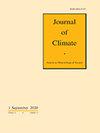Uncertainties Inherent from Large-Scale Climate Projections in the Statistical Downscaling Projection of North Atlantic Tropical Cyclone Activity
IF 4
2区 地球科学
Q1 METEOROLOGY & ATMOSPHERIC SCIENCES
引用次数: 0
Abstract
Abstract North Atlantic tropical cyclone (TC) activity under a high-emission scenario is projected using a statistical synthetic storm model coupled with nine Coupled Model Intercomparison Project Phase 6 (CMIP6) climate models. The ensemble projection shows that the annual frequency of TCs generated in the basin will decrease from 15.91 (1979-2014) to 12.16 (2075-2100), and TC activity will shift poleward and coast-ward. The mean of lifetime maximum intensity will increase from 66.50 knots to 75.04 knots. Large discrepancies in TC frequency and intensity projections are found among the nine CMIP6 climate models. The uncertainty in the projection of wind shear is the leading cause of the discrepancies in the TC climatology projection, dominating the uncertainties in the projection of thermodynamic parameters such as potential intensity and saturation deficit. The uncertainty in the projection of wind shear may be related to the different projections of horizontal gradient of vertically integrated temperature in the climate models, which can be induced by different parameterizations of physical processes including surface process, sea ice, and cloud feedback. Informed by the uncertainty analysis, a surrogate model is developed to provide the first-order estimation of TC activity in climate models based on large-scale environmental features.北大西洋热带气旋活动统计降尺度预测中大尺度气候预测固有的不确定性
摘要 利用统计合成风暴模式和九个耦合模式相互比较项目第六阶段(CMIP6)气候模式,预测了高排放情景下的北大西洋热带气旋(TC)活动。集合预测结果表明,流域内生成热带气旋的年频率将从 15.91 次(1979-2014 年)下降到 12.16 次(2075-2100 年),热带气旋活动将向极地和沿岸转移。一生最大强度的平均值将从 66.50 海里/小时增加到 75.04 海里/小时。九个 CMIP6 气候模式对热带气旋频率和强度的预测存在巨大差异。风切变预测的不确定性是造成热气旋气候预测差异的主要原因,在潜在强度和饱和赤字等热力学参数预测的不确定性中占主导地位。风切变预测的不确定性可能与气候模式中对垂直一体化温度水平梯度的不同预测有关,这可能是由包括表面过程、海冰和云反馈在内的物理过程的不同参数化引起的。在不确定性分析的基础上,建立了一个代用模式,根据大尺度环境特征对气候模式中的热带气旋活动进行一阶估计。
本文章由计算机程序翻译,如有差异,请以英文原文为准。
求助全文
约1分钟内获得全文
求助全文
来源期刊

Journal of Climate
地学-气象与大气科学
CiteScore
9.30
自引率
14.30%
发文量
490
审稿时长
7.5 months
期刊介绍:
The Journal of Climate (JCLI) (ISSN: 0894-8755; eISSN: 1520-0442) publishes research that advances basic understanding of the dynamics and physics of the climate system on large spatial scales, including variability of the atmosphere, oceans, land surface, and cryosphere; past, present, and projected future changes in the climate system; and climate simulation and prediction.
 求助内容:
求助内容: 应助结果提醒方式:
应助结果提醒方式:


